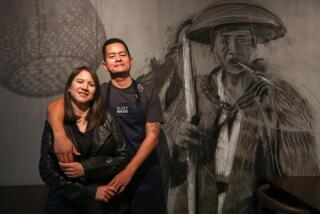Student Exchanges : American, Japanese Pupils Get a Taste of Each Other’s Cultures
It is lunchtime at Osaka Sangyo University in Studio City and students begin gathering at tables in the grassy lunch area.
“Hey man, what’s up?” 13-year-old Jon Stoll calls out to a slight Japanese teen-ager. Takeshi Nagatomo, 17, looks up, unsure of what the American youth is saying. “No! I mean, how are you,” Jon explains.
Still slightly confused, Takeshi raises his hand and slaps him a high five, a move he learned only a few days ago.
The two students, from different continents, are making the best of a bad situation. The more than 200 kindergarten through eighth-grade students from St. Michael and All Angels Episcopal Church school were displaced by the Jan. 17 earthquake and have been renting 15 classrooms at nearby Osaka. Meanwhile, 54 students from Japan arrived on campus last week for intensive English and cultural awareness classes.
The mix has made for a unique cultural experience for both groups--and important questions like “Do Super Mario Bros. video games come in Japanese?” and “How do you make an origami bird?” are being answered.
“If we had our choice we would be at the old school,” said Jim Lusby, headmaster at St. Michael’s. “But we are here and we are having this great extra-cultural benefit with the Japanese students.”
“Yeah, and they are way more polite than us,” Josh Rothman, 14, piped in. “And smarter, too.”
The Japanese students, here for three weeks as part of their International Course at Osaka Toin High School in Osaka, Japan, have studied English for the past four years, “but they don’t know how to converse because it is all book learning in Japan,” said William Price, director of English education at the university.
Enter St. Michael’s students. They are the perfect group to practice newly acquired English skills on. “English is easy to understand when they speak it,” said 17-year-old Sei Morimoto who, like all of his classmates, has been paired with a St. Michael’s student during his stay. “My partner is only 12 and he was such a deep thinker. I was surprised.”
In one corner of the lunch area, a group of American teen-agers is teaching Sei another important lesson. When asked about what was said, Sei smiles sheepishly and says the boys were helping him with American slang “that they told me not to use in public.”
But American students are not the only ones doing the instructing. Several Japanese girls sit around a lunch table teaching American students the art of origami. Their swift fingers fold the perfectly squared paper until an elegant bird emerges, while St. Michael’s students struggle to duplicate the centuries-old practice.
Throughout the day, the American students greet their Japanese counterparts in the hall with “ konnichiwa ,” or good afternoon, as the Japanese students practice a simple “hi” or “what’s up!”
Shunsuke Mochizuki 17, said the best part of the school day is lunch, when students can socialize without the watchful eye of instructors and get down to the serious business of experimenting with American food.
“They have a Japanese chef here, so we can get Japanese food, but it is fresh to have pizza,” Shunsuke said, making use of a new slang word he recently learned.
St. Michael’s campus buildings were yellow-tagged after the quake because two houses on a hill above the school are red-tagged and, therefore, unsafe. City officials deemed the school unusable until the houses are repaired or torn down, neither which has happened yet.
“We won’t be going back any time soon,” Lusby said. “No one really knows when.”
The school is renting space at the university for $15,000 a month.
At the end of the lunch period, Natalie Farrell, 9, bids farewell to her new friend, Yoko Nakagawa, 17, after a brief discussion about which Disneyland is better, the one in Anaheim or Tokyo.
“ Sayonara, “ Natalie says. “I never knew sayonara was Japanese. I thought it was Spanish or something.”
More to Read
Sign up for Essential California
The most important California stories and recommendations in your inbox every morning.
You may occasionally receive promotional content from the Los Angeles Times.










